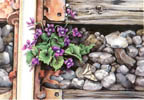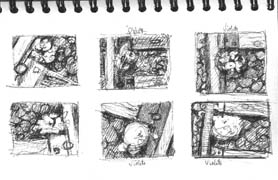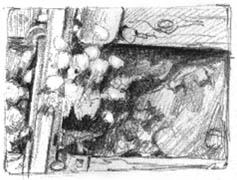
|

|
Combining Watercolor pencils
with Oil and Wax based pencils
by Barbara Krans Jenkins
|
THE CHALLENGE:
To create a painting using all three kinds of colored pencils from a
combination of sketchbook notes, photo references and working on location.
Although I prefer to work on location, I often am just not able to be there for very long. I must then come up with a way to bring my subject back to my studio to work from there. To this end, I keep an active sketchbook which I often use to refer to in the creation of my art. In addition to this, I also will use photographic references for my work, most of which I take myself.
Since a very large portion of my creative process is in the preliminary planning, I must take a little time right up front to tell you what went into this particular piece of art. For me, the "process" is the most rewarding part of my work. Perhaps I can share a little of that with you.
|
|
Preliminary work for "Fleeting Moment of Glory"
My challenge was to create a piece of art for a show a group of friends and I were doing with the theme "Lure Of The Rails". The subject had to have something to do with the Cuyahoga Valley National Park’s Railroad.
I decided I liked the idea of cropping my subject up close and capturing the combination of man-made tracks and hardware with the persistent beauty of wildflowers. Nature insists on coexistence, despite the smoke puffing mega-tons of the huge Iron and Steel train as it periodically roars over the tracks (crushing anything that lingers on them) which stretch throughout the park. I was taken with the simple beauty and textures of the wooden ties and the corroded iron hardware that held them in place. I found wildflowers as well as weeds growing among the stones between the ties.
|
|
|
Photographic References
I took about two rolls of film as I walked along the meandering Cuyahoga River and stretch of tracks in Peninsula, OH. Composing and cropping for angles and textures of the wooden ties, corroded hardware and stones. I narrowed these pictures down to just a few.
|
Sketchbook
Although I did not actually see violets growing there at that joint of the ties and rail, I did see Phlox and other wildflowers and knew that if I walked long enough, I would indeed surely see violets growing also. Besides, I am the artist, you know, so, I can choose whatever I want to put in my painting, whether it grows there or not! My sketchbooks are filled with studies I make all the time of all manner of things that catch my eye as I walk the woodlands. So, first, I examined some previous pen and ink sketches I’d made while on location of some wild phlox.
I decided, "Nope, too tall, I really like the corroded colors and textures of the iron and the weathered wood of the ties. I must pick a wildflower that is close to the ground… Violets!"
If I was working on this art work in the Spring, I could simply go out into the woods and draw on location, but, since that season had passed, I looked over my sketchbooks instead, for violets. Finding them, I decided on my color scheme. I’d use the most commonly found violets from around here, blue-violet.
|
|
|
|


|
Thumbnails
Now I made some rapid rough, almost scribbled tiny sketches with a ball point pen (because that was what I had on me at the time). These were different combinations of this and that from the photo references and the violet sketches from my sketchbooks. I was searching for the best focal point and combinations of textures and balance. Did I want this at an angle rather than the squared format the joints of the ties and rails wanted to dictate to me?
I decided "yes !"… a very slight angle, not too much off the "square". I liked the slight tension that gave the composition … definitely more interesting to me. Next, I did a graphite value sketch (another small thumbnail sketch, but I took a little more time on this one) of this final compositional decision.
|
This page copied (with permission)
from gallery.passion4art.com
|
|
